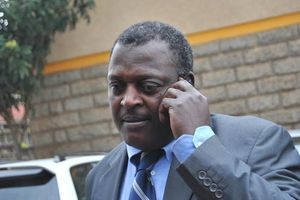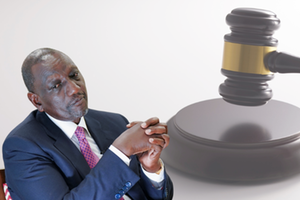
Raila Odinga in Kiambu County.
| File | Nation Media GroupPolitics
Premium
Battle for swing vote in top gear
Deputy President William Ruto and Orange Democratic Movement (ODM) leader Raila Odinga have intensified campaigns in crucial regions and demographics that could be key to determining who occupies State House in August 2022.
With its projected 5.9 million new voters by next year, according to the 2019 census, and no clear person to take over from President Uhuru Kenyatta when he retires, Mt Kenya is seen by some political strategists as joining the ranks of regions that could determine the outcome of the presidential election, but whose bloc vote remains contested.
Mr Odinga and Dr Ruto have spent days on end to woo Mt Kenya voters to their side, as the region also seeks to make its demands to the leading presidential contenders.
Other hopefuls like Wiper Party’s Kalonzo Musyoka and Amani National Congress’ Musalia Mudavadi too have been making trips to the mountain.
Based on their 2013 and 2017 patterns, when they almost evenly split their votes between Jubilee and ODM candidates, and the frequent visits by the leading candidates, other regions that will be closely watched because of their potential to swing the presidential contest are the Kisii and Nyamira counties, Narok and Kajiado counties, Northeastern, Coast and Western.
Aggressive campaigns
Mr Odinga and the DP are aggressively campaigning in these regions, aware that they hold the key to their tenancy at State House.
The United Democratic Alliance (UDA), a party associated with Dr Ruto, has lined-up a series of meetings in Mt Kenya, Narok, Kajiado, Nyanza and Western in the latest itinerary published.
The consultative regional meetings with aspirants begin on September 27 and run up to mid-October. The party and Dr Ruto aims to consolidate support at the expense of Mr Odinga who is also focusing on these regions.
The ODM leader, who met leaders from Laikipia, Samburu, Kajiado and Narok counties on Monday, was in the Coast yesterday, meeting party supporters.
The meeting was also open to members of Jubilee and the Party of National Unity (PNU) who have been working with the orange party.
The Coast visit came days after a similar meeting in Western and Nyanza where Mr Odinga has been selling his Azimio la Umoja (Quest for unity) campaign.
Saturday’s meeting was attended by ODM delegates from Kilifi, Mombasa, Lamu, Tana River, Kwale and Taita Taveta counties.
Same promises
While in Kajiado, Mr Odinga gave the same promises as his main rival if elected president.
“We are concerned about historical and current marginalisation of some parts of Kenya. It is the reason we will continue to push for more funds and resources to be devolved to counties,” Mr Odinga said.
According to ODM Secretary General, Edwin Sifuna, after the Coast, the Odinga team would head to Garissa and Turkana counties before calling a national convention in Nairobi.
“After we are done with the Coast, we will visit Garissa. The meeting will bring together delegates from Isiolo, Marsabit and Mandera counties. We will then go to Turkana County. We will listen to people from these regions on what they want addressed,” Mr Sifuna said.
Most of the areas being targeted by Dr Ruto, apart from Mt Kenya, have largely been behind Mr Odinga in the past.
Potential battle zones
A spirited campaign by Jubilee prior to the 2017 General Election increased the party’s numbers in the regions and showed they were potential battle zones, given the right motivation and campaign messaging.
In 2017, Mr Odinga garnered 801,031 votes against President Uhuru Kenyatta’s 287,606 in the six coastal counties.
Mr Odinga got 299, 380 votes from Narok, Kajiado and Samburu, against 367,603 which Mr Kenyatta received.
In 2017, Mr Odinga garnered 71,063 votes against the President’s 58,744 in Turkana County.
According to the 2019 national census, Kajiado and Narok counties have 272,033 and 249,756 potential new voters.
Potential swing counties of Bungoma, Kakamega, Kilifi and Turkana are also projected to add to their figures a combined 1.4 million new votes.
Based on these projections, Nyanza, Western and Coast could collectively have 9.1 million voters next year.
President Kenyatta’s restive political backyard of Mt Kenya, slowly taking shape as the country’s biggest swing vote in 2022, has a potential of 5.9 million new voters.
Ethnic balkanisation
While the President garnered a paltry 66,000 votes from the four Western counties in 2013, the figure shot to 242,000 in 2017 – a number Dr Ruto is keen on improving on, going by his frequent visits.
In fact the DP intensified the hunt for these votes this weekend as he held campaigns in Khumusalaba in Malava constituency, Kakamega County.
Before heading to Khumusalaba yesterday, the DP met a delegation from Bungoma at his Sugoi home in Uasin Gishu County.
He has also met leaders from Mt Kenya, Coast, Western and Nyanza and is expected to have similar meetings with delegations from Northeastern, Eastern, Rift Valley and Nairobi.
In his economic blueprint meetings, the DP gives promises specific to the regions even as he promises to adopt a national document.
With Mt Kenya having no clear heir to President Kenyatta, Dr Ruto and Mr Odinga have promised to address the plight of the region’s farmers by prioritising value-addition to improve on earnings.
The two leaders have also pledged to protect businesses with affordable loans and reducing taxes.
While the DP promises to revitalise agriculture and provide loans for those interested in business in Mt Kenya, Mr Odinga says he will focus on reforms in tea, coffee, dairy and a number of other industries started by Agriculture Cabinet Secretary Peter Munya.
In Western Kenya, the two leaders have given similar promises, including the revival of collapsed factories and improving infrastructure. Dr Ruto has even promised an international airport.
The intense focus on potential swing vote regions by the two leading presidential contenders, however, does not sit well with some parts of the country who view it as ethnic balkanisation.
Prof Winnie Mitullah of the University of Nairobi faulted the two for putting their efforts on “ethnic blocs” instead of the national agenda.
“A presidential candidate should have a holistic look of a nation. You must have an agenda for the country. You can bring it down to regions but we are a devolved system. Governors are there to take on the politics of regions,” Prof Mitullah told the Nation Saturday.
“When national leaders start discussing agendas along regions, there are problems. This is taking us back to regional and ethnic blocking.”
According to the don, the leaders are in a dilemma as they do not know if to champion national interests instead regional ones.
“On the other hand, they want votes and votes are not won by big words. They are pulling between articulating national issues and going more to the lower level. They are looking at local votes and failing to articulate issues of national interests,” Prof Mitullah argued.
Divisive politics
Prof Ken Oluoch, who heads the Political Science Department at Moi University, said even though the leaders are using different strategies to win votes, they should not split the country.
“Politicians have rights to sell their economic agenda. Their strategies tell of the realisation that the national economy and the people’s economic status really matter in getting votes. The divisive nature of politics is unfortunate,” Prof Oluoch said.
“The kind of politics played should enhance national cohesion and focus on national development.”
However, Mr Sifuna dismissed the notion of Mr Odinga dividing the country by holding meetings in regions,.
The ODM secretary general argued that every region’s agenda is what later forms the national one.
“The national agenda is an amalgamation of all the agenda. These regions want unity, peace and economic prosperity,” he told the Nation Saturday.
UDA chairman and former Machakos Senator, Johnson Muthama, said having the different economic forums is changing the political landscape of the country, adding that it is aimed at giving the party an advantage over its rivals.
“We have decided to accurately identify the problems from every region. By the time we form the government, we know what a particular region needs. The government should not launch projects that have not been identified by the people themselves,” Mr Muthama said.
He added that UDA has not formalised its manifesto since every region has been presenting particular requests “expected to be implemented when Dr Ruto becomes president next year”.





